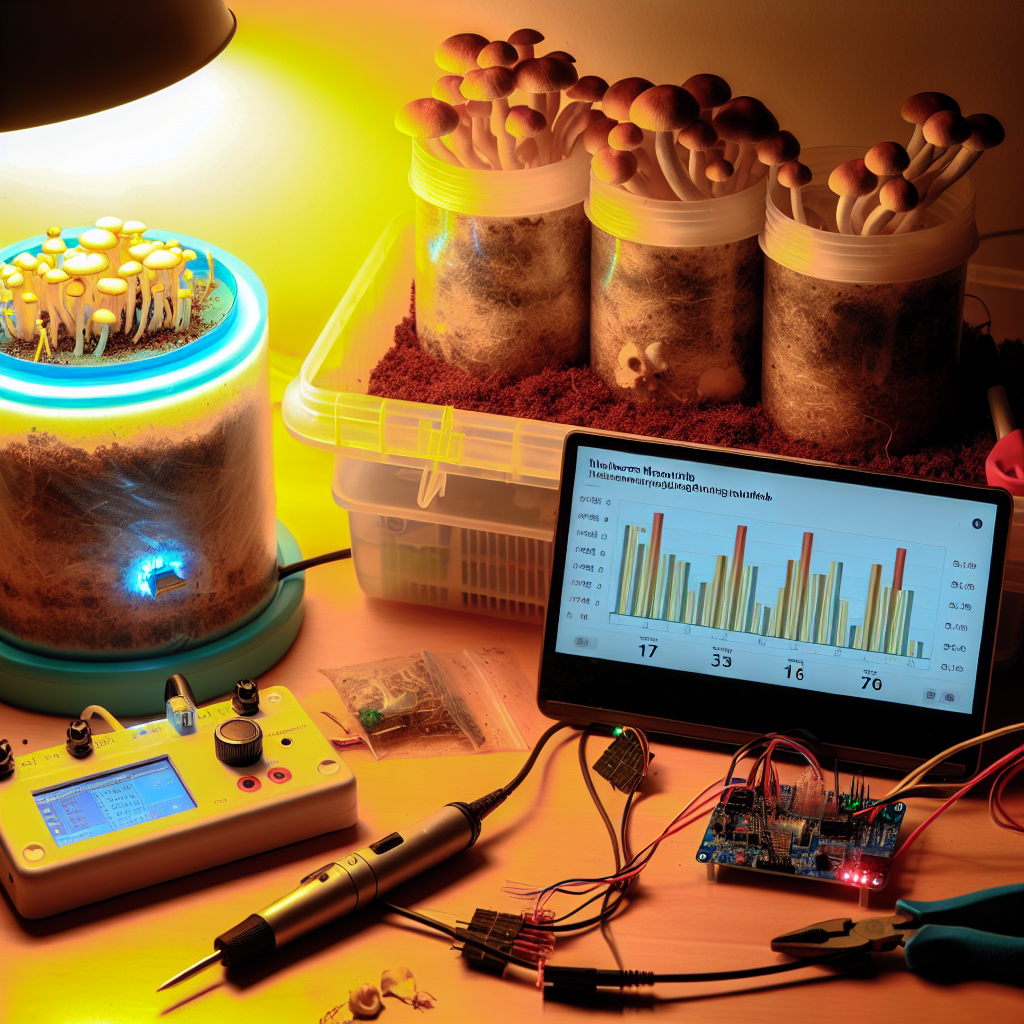Mushroom Monotub Automation: Smart Controller DIY Guide
Introduction: Cultivate Smarter, Not Harder
As the interest in functional and medicinal mushrooms continues to surge, both home cultivators and professionals are looking for more efficient and sophisticated ways to manage their mushroom grows. One of the most popular methods for growing mushrooms at scale in a home or small-scale commercial setting is the monotub method. It’s a tried-and-true approach that relies on creating the ideal microclimate for substrate colonization and fruiting. However, maintaining that perfect environment manually can be tedious and error-prone.
That’s where automation enters the scene. By integrating a smart controller system into your monotub setup, growers can not only minimize manual labor but also achieve consistent and optimized growth conditions. From maintaining humidity and CO₂ levels to regulating light and airflow, a smart controller opens up a new frontier in mushroom cultivation. For cannabis professionals and enthusiasts with a background in indoor horticulture, applying similar environmental controls to mushroom cultivation is a natural progression.
The DIY community has grown immensely, especially among those enthusiastic about psychedelics and natural healing. With psilocybin mushrooms being decriminalized or legalized in a growing number of cities and states for therapeutic purposes, the demand for efficient home-growing setups has soared. The same kind of tech-forward solutions used in cannabis grows—such as PLC systems, Raspberry Pi microcontrollers, or Arduino kits—can also be effectively adapted for managing the needs of a mushroom monotub.
This blog post is a comprehensive, step-by-step guide to building your own smart controller system tailored specifically for monotub setups. We’ll explore which sensors and components you need, how to program them, and how to integrate remote monitoring for full automation. Whether you’re a home cultivator aiming to streamline your grow process, a cannabis professional expanding into fungi, or just a tech-savvy hobbyist, this guide provides the blueprint to bring your mushroom cultivation into the 21st century.
Why Automate? The Science Behind Smart Mushroom Growth
The cultivation of mushrooms—particularly species like Psilocybe cubensis, Lion’s Mane (Hericium erinaceus), and Reishi (Ganoderma lucidum)—depends deeply on maintaining strict environmental parameters. Humidity, temperature, CO₂ concentration, and light cycles control the yield, potency, and overall health of mushroom flushes. Inconsistent environmental regulation can result in slow growth, contamination, or reduced bioactive compound levels.
Researchers have long studied the influence of environmental parameters on mycelial development. A 2021 review published in the journal *Mycology* emphasized the significant effect of CO₂ levels during the fruiting phase and recommended CO₂ levels below 1000 ppm for most species to ensure strong fruiting body formation (Yadav et al., 2021). Automating CO₂ control via sensors connected to exhaust fans or air pumps can make a critical difference in outcomes.
Humidity is another essential component. A 2020 article from *International Journal of Medicinal Mushrooms* found that maintaining relative humidity between 85%-95% during fruiting stages drastically improved cap development and overall biomass (Chandra et al., 2020). Manual misting or imperfect humidifiers often fail to sustain these levels consistently. Automating water atomizers or ultrasonic humidifiers via relay switches and humidity sensors like the DHT22 can easily resolve this challenge.
Temperature control also plays a defining role, especially for sensitive species. Although room temperature is often suitable for cubensis, other mushrooms like Shiitake or Enoki may require more regulated thermal environments. Integration of temperature sensors and temperature-controlled fans or heating mats can ensure species-specific microclimates, improving yields and reducing contamination risk.
There’s a rising body of evidence suggesting improved yield consistency and faster colonization via automated environmental control. One notable case study by Fungi Perfecti, the company founded by renowned mycologist Paul Stamets, demonstrated that controlled humidity and CO₂ environments improved Lion’s Mane biomass yields by up to 30% over non-automated methods.
Key Components: What You’ll Need to Build a Smart Monotub Controller
From a DIY perspective, the accessibility of programmable microcontrollers like Arduino and Raspberry Pi has never been higher. Smart farming systems that used to cost thousands can now be built for under $150. Key components include:
– Humidity and CO₂ sensors
– Light sensors or timers
– Relays for controlling electrical devices like fans/misters
– Wi-Fi modules for remote control
– Touchscreen interfaces or smartphone compatibility
GitHub repositories and open-source Arduino libraries have democratized the process even further, with templates and codes pre-loaded for mushroom cultivation modules. These systems can also collect data on environmental conditions over time, leading to better strain selection and process optimization for professional growers.
For cannabis operators, branching into mushroom cultivation with this smart controller system becomes a logical extension of existing practices. Using similar automation principles allows cross-applying knowledge while reducing operational friction, making it an ideal expansion opportunity in a diversifying therapeutic market.
DIY Smart Controller Build Tips: Step-by-Step Success
1. Choose Your Microcontroller
Raspberry Pi is great for remote monitoring and flexibility. Arduino is ideal for low-cost builds with instant sensor integration.
2. Research Sensors
DHT22 for humidity/temperature, MH-Z19B for CO₂, BH1750 for light detection.
3. Automate Outputs
Use relays to connect automation systems to humidifiers, exhaust fans, and LED grow lights.
4. Set Thresholds
Program your ideal environmental ranges using hysteresis loops to avoid rapid flapping of devices.
5. Log Your Data
Track your environmental conditions and mushroom growth via CSV exports or Bluetooth syncing apps.
6. Remote Access Integration
Use platforms like Blynk or Home Assistant for smartphone dashboard management and notifications.
Conclusion: Your DIY Monotub, Reimagined
Automating your monotub not only streamlines the growing process—it elevates it. For consumers and professionals alike, harnessing modern technology to control light, humidity, CO₂, and temperature delivers more consistent yields and higher-potency mushrooms. Whether you’re pursuing therapeutic fungi like psilocybin or functional types like Lion’s Mane, a smart controller puts power and precision into your hands. The fusion of DIY ingenuity, scientific backing, and modern microcontroller technology makes this a must-try evolution in the cultivation space.
Concise Summary:
This comprehensive guide explores how to build a smart controller system for automating mushroom monotub cultivation. By integrating sensors, microcontrollers, and remote monitoring, growers can precisely control environmental factors like humidity, temperature, and CO2 levels to optimize yield, potency, and consistency. The article covers key components, step-by-step build tips, and the science behind automating mushroom growth, making it a valuable resource for home cultivators, cannabis professionals, and tech-savvy hobbyists.
Reference Hyperlinks:
[1] Yadav, M., Singh, R. K., & Verma, A. (2021). Environmental Factors Influencing Fruiting Body Formation in Edible Mushrooms. *Mycology.* https://www.tandfonline.com/doi/full/10.1080/21501203.2021.1895694
[2] Chandra, R., Lata, H., & Gautam, R. K. (2020). Effects of Relative Humidity and Temperature on Fruiting of Medicinal Mushrooms. *International Journal of Medicinal Mushrooms.* https://www.begellhouse.com/journals/medicinal-mushrooms.html
[3] Fungi Perfecti Case Studies: https://fungi.com/pages/research-initiatives
[4] Arduino Sensor Reference: https://www.arduino.cc/reference/en/
[5] Raspberry Pi Projects for Mushroom Cultivation: https://projects.raspberrypi.org/en/
[6] Blynk IoT Automation Platform: https://blynk.io/




